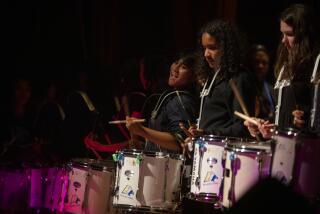EDUCATION IN THE ‘ARTS NOT A FRILL’
- Share via
Pointing out that the arts so far have been “primarily the province of a minority” instead of “part of the lives of the majority,” National Endowment for the Arts Chairman Frank Hodsoll urged a “broad national coalition to make serious and sequential arts education part of basic education reform.”
“Our young people deserve to have their eyes, ears and minds opened to civilization . . . they deserve to know about art,” Hodsoll said Saturday.
Closing the first national conference sponsored by the Getty Center for Education in the Arts--”Disciplined-Based Art Education: What Forms Will It Take?”--Hodsoll, in effect, echoed what Secretary of Education William J. Bennett said Friday: that “the study of the arts is just as essential to the education of a disadvantaged child as it is for any other.”
Both applauded the Getty’s approach featuring not just art production or the creative element in art education but art history, art criticism and aesthetics. Drawing upon the Department of Education’s recent study of Japanese schools, both spoke somewhat enviously of what the Japanese are doing.
Bennett noted that Japanese students are familiar with, and know the difference between, Manet and Monet, while Hodsoll said, “The Japanese require two class periods a week each in music and art and handicrafts, each year, grades one through six. . . . Two more courses a week are required each in music and fine arts in grades seven and eight, and one course per week in each of these in grade nine.
“In middle school,” Hodsoll continued, “students learn to sing in a chorus and play musical instruments in an ensemble, and acquire a broad acquaintance with classical Japanese music, world folk songs, and classical, modern Western and Japanese orchestral and solo music. Basic music theory and history are also covered,” he added, while there is “continued training in painting, sculpture and graphic design.” In secondary school, there are “requirements in music or calligraphy.”
As for American schools, Hodsoll allowed that it will take “decades to make a difference.” And he posed a few questions: “How does one do it? How does one allocate and use existing and future resources--teachers, textbooks, school facilities, budgets. . . .
“The achievement of desired competencies has to be related to specific students and specific teachers in specific schools,” he added. “For example, studio art cannot be required if there are no qualified teachers to teach it.” To begin the process of a “serious and sequential” arts education--or as Hodsoll says, making every high school graduate “literate in the arts”--the endowment, in three weeks, will award its first “basic education grants” totaling more than $250,000 to 16 states to begin the planning phase of a disciplined-based arts program.
Moreover, the Getty Center has helped mount disciplined-based programs in 21 Los Angeles county districts and in 10 school districts (including the state of Arizona) across the country. The Getty and the endowment are also collaborating on a pilot television program for 8- to 10-year-olds.
Leilani Lattin Duke, director of the Getty Center, cautioned when the conference began that there were “probably as many skeptics as there are advocates” of disciplined-based art education. Indeed, during a panel discussion on museum education, Bret Waller, associate director of the Getty Museum for education and public affairs, noted that “on the negative side” students who had too much of identifying such figures as cone cylinders and spheres in works of art, “when they confronted a Madonna and Child saw (only) triangles and rectangles.” However, he noted that teachers, trained for a disciplined arts curriculum, “tended to be more articulate, verbal and less intimidated” in front of works of art, while their students at least knew how to pose questions.
For many, the conference’s emotional high point came with the speech Friday night of Ernest L. Boyer, president of the Carnegie Foundation for the Advancement of Teaching. “The arts are not a frill,” Boyer said. “They are an essential part of language.”
The arts are needed in education because “they help children express feelings,” because through the arts children will “learn a visual language” and because, he said, “we live in a dangerous, interdependent world. Today’s students need to learn not just the language of politics and propaganda, they also need to learn languages that transcend intellectual and ideological barriers. . . .”
Boyer spoke, poetically, of the place of arts in language, and received a standing ovation. He said:
“At some moment, in the misty dawn of time, the written and spoken language was extended and enriched. Poets began to use words to create metaphors, forcing us to view familiar things in unfamiliar ways while the rhythm of words carried another kind of meaning.
“But even with the beauty and the power of the written and the spoken word, our miraculous use of language was incomplete. There remained buried in the bosom of the human spirit, those human experiences that could not be captured by the sounds and verbal impressions we call words.
“These symbols simply could not portray adequately enough such joy as the coming of spring or the fruits of a fall harvest or the grief and loneliness that marked the ending of a love relationship with others,” Boyer said. “They could not convey the sound of the babbling of the brook or the setting of the evening sun. For the most intimate, most profoundly universal experiences we needed a more subtle, more sensitive set of symbols than the written and the spoken word. And this richer language we call the arts. “
More to Read
The biggest entertainment stories
Get our big stories about Hollywood, film, television, music, arts, culture and more right in your inbox as soon as they publish.
You may occasionally receive promotional content from the Los Angeles Times.










